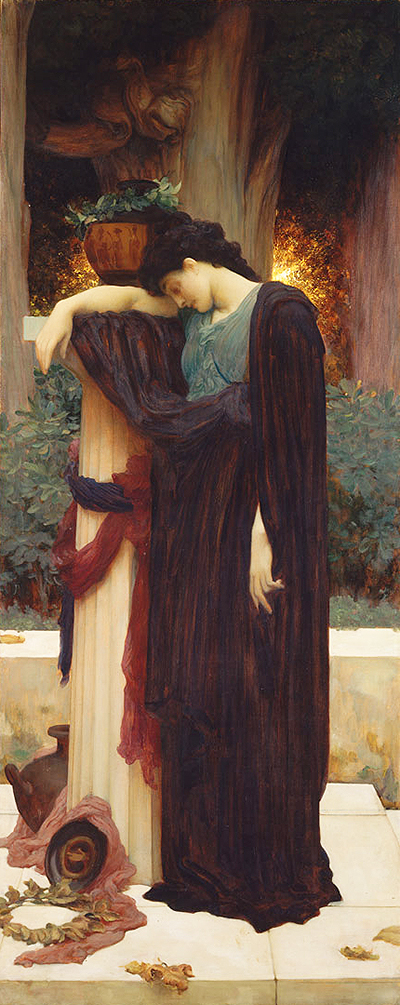Lord Frederic Leighton painted Lachrymae in 1895, one year before his death. The work of art is a testament to the Victorian artist's distinctive sophistication. The title of the painting reflects the melancholy and sadness, which define the artwork.
Lachrymae captures a young lady leaning on a Doric column, looking down at the withered crown. The woman's position symbolizes sadness and loss. She wears a black cloak over a green dress and rests her head on her right arm, which is set on the column's capital. Her left arm is pointing downwards and appears from under the cloak. Her entire body is powerless in the face of her grieving. The dead leaves on the marble floor and the two Greek vases reinforce the scenery's melancholic sentiment. Behind the low wall, which delimits the scene, a dark and thick tree appears. The strong tree symbolizes the woman's power to overcome her loss. The artist achieves a powerful contrast between the main setting, which emphasizes loss and the secondary setting, which represents life and the woman's strength to pass through her grief.
The artist finished the painting in 1895. The Leighton House Museum in London holds several sketches made by Lord Leighton including the woman's portrait and the cypress tree. The woman who posed for the painting is identified as Miss Lloyd, who supposedly posed for several paintings made by the artist.
The work of art comprises classical elements such as the Doric column, the statue-like position of the woman and the vases. What's more, the frame, which captures the scene, symbolizes the entrance into a temple. The painting's surface is smooth and the shapes are sophisticated. The painting has a vertical and rectangular format, which strengthens the slim figure of the grieving lady. The artwork places the protagonist in the centre. The woman's figure represents a quarter of the painting. The wall delimits the first and second settings. The painting's symmetry is clearly represented by the central trunks and the lateral trees.
The painting's colours are melancholic and represent the woman's heartache and sorrow. The colours are warm but strong. The protagonist is covered by a black cloak and a dark scarf is set around the column. The woman is looking to find strength and rests on the column for support. The artist uses light colours at the bottom of the painting and gradually uses darker colours towards the top. The burst of light from behind the tree is symbolic of life and of the woman's hope. Lachrymae by Lord Leighton is a melancholic painting, which reflects the contrast between the sadness which follows a loss and the hope of a new beginning. The painting was first exhibited at the Royal Academy of Arts in London in 1985. Today you can admire the oil on canvas at the Leighton House Museum in London.




